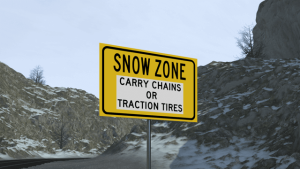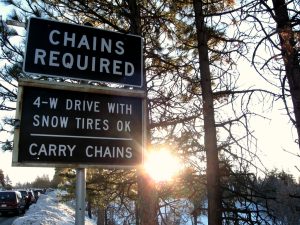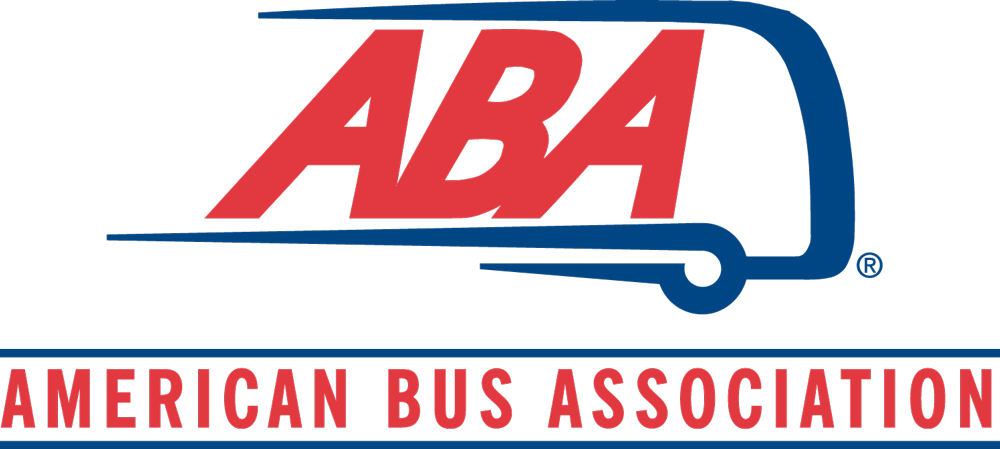Tire Chain Laws
Most every state in the U.S. has laws pertaining to the use of tire chains or snow tires. These laws dictate when you can, should, and absolutely must use tire chains, as well as when it’s not permitted. Some states will post signage or declare a snow emergency to indicate that tire chains are needed. Other states leave it up to the driver but indicate that chains may be used if conditions warrant.


It’s important for CMV drivers to familiarize themselves with the chain laws in the states they normally run.
Click here for a pamphlet on how to place and affix tire chains.
| State | Summary |
| Alabama | The use of tire chains shall be permitted upon any vehicle when required for safety because of snow, rain, or other conditions tending to cause a vehicle to slide or skid. |
| Alaska |
You are not permitted to use chains from May 1 through September 15 when north of 60 North Latitude. You are not permitted to use chains from April 15 through September 30 when south of 60 North Latitude. If you are operating a vehicle on Sterling Highway, you are not permitted to use chains from May 1 through September 15. You will need to obtain a special permit from the Department of Administration if you would like to use chains in one of these prohibited zones. |
| Arizona | The use of tire chains are allowed when required for safety during a time of snow, ice, or another condition that might cause slippery highways. |
| Arkansas | The use of tire chains are allowed when required for safety during a time of snow, ice, or another condition that might cause slippery highways. |
| California |
California requires drivers to stop and put on chains when highway signs indicate chains are required. Drivers can be cited by California Highway Patrol and fined if they don’t. Typically, drivers have about a mile between “chains required” signs and the checkpoint to install chains. During winter weather, it takes at least eight chains for the standard tractor-trailer configuration to comply with the regulations. During the winter months, there might be traction chain controls in the mountain areas. When these are established you will see signs posted along the highway. These signs will also include the type of requirement, which will include one of the following: R1 – Chains, traction devices or snow tires are required on the drive axle of all vehicles except four wheel/ all wheel drive vehicles. |
| Colorado |
Commercial motor vehicles (CMVs) and trucks must have chains. Vehicles without chains can often lose traction, causing traffic delays and sometimes road closures. For the safety of the traveling public, it’s critical to use chains to be in compliance with Colorado’s chain law. From September 1 through May 31, all CMVs must carry enough chains on I-70 when traveling between mile marker 259 outside Golden, CO and mile marker 133 in Dotsero, CO. If you get stopped and do not have chains on your truck, the fine is $50 plus a surcharge of $16. If you do not put chains on your CMV when the law is in effect, the fine is $500 plus a $79 surcharge. If you do not put chains on and you end up blocking the highway, then the fine will increase to $1,000 plus a $156 surcharge. Colorado has two different types of chain laws: Level 1 – Single-axle combination commercial vehicles must chain up. Trucks must have all four drive tires in chains. When level 1 is in effect, all other commercial vehicles must have snow tires or chains. |
| Connecticut |
Chains are permitted only from Nov. 15 through April 30. The chains can not be damaging to the highway’s surface. |
| Delaware |
You are permitted to use chains on highways from October 15 through April 15 “for safety because of snow, ice or other conditions tending to cause a vehicle to slide or skid.” State officials can restrict travel on highways during emergency situations. |
| Georgia |
At any time the Georgia Department of Transportation may close or limit access to certain highways during inclement weather. If this occurs, signage will be placed to inform drivers that chains are required in order to proceed. For commercial vehicles, chains must be placed on the outermost drive tires. |
| Idaho | Officials with the Idaho Department of Transportation can determine that it is unsafe to drive over Lookout Pass and Fourth of July Pass on I-90, and Lolo Pass on Highway 12. If it is deemed unsafe, then you will be required to chain up a minimum of one tire on each drive axle and one axle at or near the rear. Advance notices of chain requirements will be posted by Idaho DOT. |
| Illinois | The use of tire chains are allowed when required for safety during a time of snow, ice, or another condition that might cause slippery highways. |
| Indiana | The use of tire chains are allowed when required for safety during a time of snow, ice, or another condition that might cause slippery highways. |
| Iowa | The use of tire chains are allowed when required for safety during a time of snow, ice, or another condition that might cause slippery highways. |
| Kansas | The use of tire chains are allowed when required for safety during a time of snow, ice, or another condition that might cause slippery highways. |
| Kentucky | No person shall use on a highway not covered with ice a vehicle with a chained wheel unless the wheel rests upon an ice-shoe at least 6 inches wide. When chains are used on rubber-tired vehicles, the cross chains shall be not more than three-fourths (3/4) of an inch in thickness or diameter, and shall be spaced not more than ten inches apart, around the circumference of the tires. |
| Louisiana | The use of tire chains are allowed when required for safety during a time of snow, ice, or another condition that might cause slippery highways. |
| Maine | Vehicles cannot have tires with metal studs, wires, spikes or other metal protruding from the tire tread from May 1 through Oct. 1. Other than that the use of tire chains are allowed when required for safety during a time of snow, ice, or another condition that might cause slippery highways. |
| Maryland | The use of tire chains are allowed when required for safety during a time of snow, ice, or another condition that might cause slippery highways. |
| Massachusetts | Massachusetts prohibits the use of studded tires and chains between May 1 and Nov. 1 without a permit. Tire chains are allowed when required for safety during a time of snow, ice, or another condition that might cause slippery highways. |
| Michigan | The use of chains is allowed for safety when snow, ice, or other condition are present. If chains are used, they must not come in direct contact with the roads surface |
| Mississippi | The use of tire chains are allowed when required for safety during a time of snow, ice, or another condition that might cause slippery highways. |
| Missouri | No person shall operate any motor vehicle upon any road or highway of this state between the first day of April and the first day of November while the motor vehicle is equipped with tires containing metal or carbide studs. The use of tire chains are allowed when required for safety during a time of snow, ice, or another condition that might cause slippery highways. |
| Montana |
If the Montana Department of Transportation determines that highways are too dangerous for travel, they may establish the following recommendations: * Chains or other approved traction devices are recommended for drive wheels. |
| Nebraska | The use of tire chains are allowed when required for safety during a time of snow, ice, or another condition that might cause slippery highways. |
| Nevada |
It is unlawful for any person to operate a motor vehicle, whether it is an emergency vehicle or otherwise, without traction devices, tire chains or snow tires upon any street or highway, under icy or snowy conditions, when the highway is marked or posted with signs for the requirement of traction devices, chains or snow tires. If a highway in this State is marked or posted with signs requiring the use of traction devices, tire chains or snow tires, a motor vehicle or combination of vehicles must be equipped with: * Traction devices, tire chains or snow tires if it has a gross weight or combined gross weight of 10,000 pounds or less. |
|
New Hampshire | The use of tire chains are allowed when required for safety during a time of snow, ice, or another condition that might cause slippery highways. |
|
New Jersey | The use of tire chains are allowed when required for safety during a time of snow, ice, or another condition that might cause slippery highways. |
|
New Mexico | The use of tire chains are allowed when required for safety during a time of snow, ice, or another condition that might cause slippery highways. |
| New York | The use of tire chains are allowed when required for safety during a time of snow, ice, or another condition that might cause slippery highways. |
|
North Carolina | The use of tire chains are allowed when required for safety during a time of snow, ice, or another condition that might cause slippery highways. |
| North Dakota | North Dakota allows metal studs within 1/16 inch beyond tread from Oct. 15 through April 15. The use of tire chains are allowed when required for safety during a time of snow, ice or another condition that might cause slippery highways. |
| Ohio | The use of tire chains are allowed when required for safety during a time of snow, ice, or another condition that might cause slippery highways. |
| Oklahoma | The use of tire chains are allowed when required for safety during a time of snow, ice, or another condition that might cause slippery highways. |
| Oregon |
Oregon’s law applies to all highways in the state. Signs will tell you when you are required to carry chains and when you are required to use them. You will need to have six chains on hand to comply in Oregon. The use of tire chains are allowed when required for safety during a time of snow, ice, or another condition that might cause slippery highways. |
| Pennsylvania | The use of tire chains are allowed when required for safety during a time of snow, ice, or another condition that might cause slippery highways. |
|
Rhode Island | The use of tire chains are allowed when required for safety during a time of snow, ice, or another condition that might cause slippery highways. |
|
South Carolina | The use of tire chains are allowed when required for safety during a time of snow, ice, or another condition that might cause slippery highways. |
|
South Dakota | The South Dakota DOT has the authority to restrict travel on roads. Signs will alert CMVs to these restrictions. The use of tire chains are allowed when required for safety during a time of snow, ice, or another condition that might cause slippery highways. |
| Tennessee | The use of tire chains are allowed when required for safety during a time of snow, ice, or another condition that might cause slippery highways. |
| Texas | The use of tire chains are allowed when required for safety during a time of snow, ice, or another condition that might cause slippery highways. |
| Utah |
When any designated highway is so restricted, no vehicle shall be allowed or permitted the use of the highway during the period between Oct. 1 and April 30, or when conditions warrant due to adverse, or hazardous weather or roadway conditions, as determined by the Utah Department of Transportation, unless: An operator of a commercial vehicle with four or more drive wheels, other than a bus, shall affix tire chains to at least four of the drive-wheel tires. |
| Vermont |
Vermont has a traffic committee that will decide if use of chains will be required. The regulation mandates that the “advance notice shall be given to the traveling public through signage and, whenever possible, through public service announcements.” This language also mandates that adequate space be provided to chain up. Vehicles with semitrailers or trailers that have a tandem-drive axle towing a trailer shall have chains: * On two tires on each side of the primary drive axle, or if both axles of the vehicle are powered by the drive line, one tire on each side of each drive axle; and |
| Virginia | The use of tire chains are allowed when required for safety during a time of snow, ice, or another condition that might cause slippery highways. |
| Washington |
All vehicles over 10,000 pounds GVW shall carry a minimum of 2 extra chains for use in the event that road conditions require the use of more chains or that chains in use are broken or otherwise made useless, WAC 204-24-050 (2) (f). Approved chains for vehicles over 10,000 pounds gross vehicle weight shall have at least two side chains attached sufficient cross chains of hardened metal so that at least one cross-chain is in contact with the road surface at all times. Plastic chains shall not be allowed. The Washington State Patrol may approve other devices as chains if the devices are equivalent to regular chains in performance (cable chains allowable). Diagram of proper chain placement (PDF 20KB) for different axle configurations On the following routes, all vehicles and combinations of vehicles over 10,000 pounds shall carry sufficient tire chains to meet the requirements from November 1 to April 1 of each year or at other times when chains are required for such vehicles: I-90 between North Bend (MP 32) and Ellensburg (MP 101) Vehicles making local deliveries as indicated on bills of lading and not crossing the mountain pass are exempt from this requirement if operating outside of the chain required area. The Washington State Department of Transportation or Washington State Patrol may prohibit any vehicle from entering a chain/approved traction tire control area when it is determined that the vehicle will experience difficulty in safely traveling the area. |
| West Virginia | The use of tire chains are allowed when required for safety during a time of snow, ice, or another condition that might cause slippery highways. |
| Wisconsin | The use of tire chains are allowed when required for safety during a time of snow, ice, or another condition that might cause slippery highways. |
| Wyoming |
Wyoming’s chain law includes two levels of restrictions that can be implemented on specific highway sections when conditions warrant. Wyoming’s chain law includes two levels of restrictions that can be implemented on specific highway sections when conditions warrant. Level 1: When conditions are hazardous, travel can be restricted to vehicles equipped with tire chains, vehicles with adequate snow tires, or all-wheel-drive vehicles. Level 2: When conditions are extremely hazardous, travel can be restricted to vehicles equipped with tire chains or all-wheel-drive vehicles equipped with adequate mud and snow or all-weather-rated tires. Under Level 2, commercial vehicles must have chains on at least two of the drive wheels at opposite ends of the same drive axle. Do not stop in the driving lane to install or remove chains! Penalties for violations: $250 for violating the travel restriction; or |
